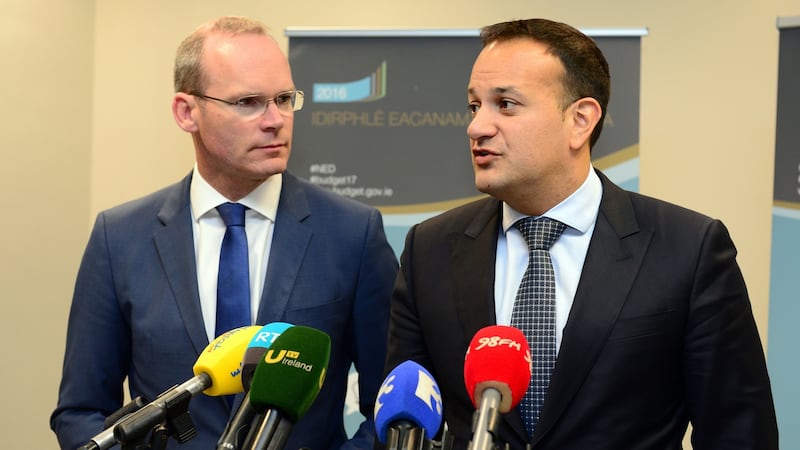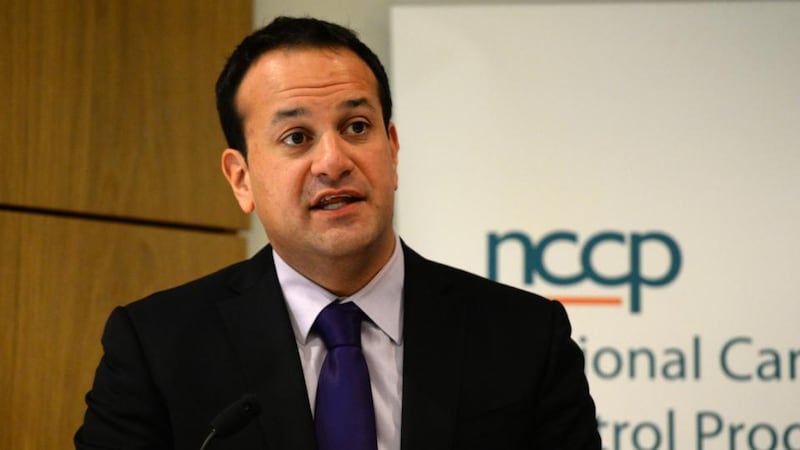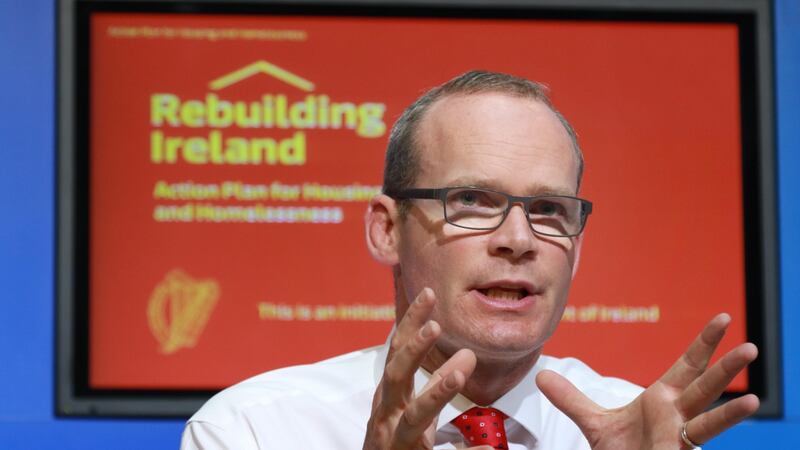The playwright Tom Murphy has always insisted that the most important question about any drama is: what is at stake? As the long-heralded Leo and Simon Show begins its run at last, we know that there will an entertaining drama to fill the news pages and keep the airwaves abuzz.
It will be, in its own way, absorbing and even compelling. But the Murphy question hovers uneasily over the action: what is at stake?
FG leadership tracker: Track the contest and check who your local TD, Senator, MEP and councillor is supporting.
For political insiders, of course, the question is absurd. The answer could not be more obvious: it’s being taoiseach, stupid. It’s the big one, the grand prix, the chance to stand at the summit and be master of all you survey in the confined but charming landscape of Irish politics.
At the very worst, the winner almost certainly gets to be taoiseach for a few months, until Fianna Fáil decides to pull the plug.
At best, given the youth of the contenders and Fine Gael's relatively secure place in a fragmented political system, Leo Varadkar or Simon Coveney could go on to dominate Irish politics for a decade or even two.
This should feel like a generational shift. Varadkar is just 38. He has Indian heritage and is openly gay. Any one of these three attributes would have seemed extraordinary in any previous prospective taoiseach. His very presence as the favourite going into the contest ought to make us acutely conscious of the scale and speed of social change since he was born in 1979.
Simon Coveney is admittedly a more traditional figure – in some respects a typical dynastic politician, who inherited his seat after his father’s tragic death in 1998. But he is still a young man – if he becomes taoiseach, he will do so shortly after his 45th birthday.
This is not a struggle for the soul of Ireland – it's not even a struggle for the soul of <a class="search" href='javascript:window.parent.actionEventData({$contentId:"7.1213540", $action:"view", $target:"work"})' polopoly:contentid="7.1213540" polopoly:searchtag="tag_organisation">Fine Gael</a>
Even with the generational shift that was forced by the Irish national revolution, WT Cosgrave was 42 when he took office in 1922 and Eamon de Valera was 49 when he did so ten years later.
So why is the sense of a generational shift so muted? Whichever of them wins, it seems safe to say that it is not going to feel like the ascent of John F Kennedy in the US in 1960, of Tony Blair in the UK in 1997 or of Emmanuel Macron in France earlier this month.
If there is a wave of youthful optimism, it will make at most a gentle lapping sound in a sheltered cove. The contest will add to the gaiety of the nation for a fortnight, but outside the political bubble, most people will find it hard to answer that nagging question: what is at stake?
Hot and bothered
In truth, this is not the World Poker Championship – it’s a game played for five cent pieces across Fine Gael’s kitchen table. People can get very hot and bothered at family card games, and things can even turn quite nasty. But in the end they just don’t matter very much.
This is not a struggle for the soul of Ireland – it's not even a struggle for the soul of Fine Gael.
To acknowledge this is not to disparage either man – both are amiable, articulate, intelligent and politically skilled enough to have got this close to the top. But for there to be something at stake, there would have to be very clear differences between them: differences of ideology, experience, vision and demonstrated capacity to deal with Ireland’s long-term social crises.
The truth is that the distances that separate them have to be surveyed with a microscope rather than a theodolite.
They are both male. Both are professional politicians who never even flirted with youthful radicalism: Varadkar joined Fine Gael in school; Coveney had it in the blood and worked on his father’s election campaigns as a child.

Both grew up in the era after Margaret Thatcher and Ronald Reagan had shifted the dominant political discourse far to the right and made the so-called (and miscalled) free market an article of faith.
Both came from comfortable families and attended expensive private schools: Varadkar at King’s Hospital in Dublin; Coveney at Clongowes Wood. (Though one of the few interesting aspects of his youth is that he was expelled from Clongowes during his transition year for what seems to have been rather minor rule-breaking.)
Both exude an air of competence and confidence while having the political nous to suppress any sense of entitlement or arrogance. Both are broadly liberal in the social as well the economic sense: Coveney ran Fine Gael’s campaign in the same-sex marriage referendum; Varadkar gave it a huge boost by talking publicly about his own sexuality for the first time.
Coveney has made more cautious noises about abortion, but there is little expectation that either man would deviate greatly from the path of reforming the law as narrowly as possible.
In general, Varadkar has more successfully projected himself as a straight talker – but there is not much sign that his straight talking has really changed the policies or direction of the two governments of which he has been a member.
Most importantly, Varadkar and Coveney have each had a chance in ministerial office to confront one of Ireland’s great social problems: respectively the health service and the housing crisis.
Varadkar wasn't willing to articulate any view at all on the most fundamental issue: how should health care be paid for?
Health and housing are two of the things that matter most in a decent society – they shape people’s lives. If one or other of the contenders could reasonably be said to “deserve” to be taoiseach, it would be because he had shown the drive, the imagination and the moral passion to create real change.
These are the fiery crucibles in which the qualities of leadership should be forged. But in neither case does the evidence point to anything all that hot.
Chronic disorganisation
Varadkar was minister for health for almost two years, up to May 2016. This was not a full term, and he inherited a system whose chronic disorganisation had been exacerbated by the acute symptoms of drastic cutbacks in previous years.
But he had two advantages: he knew the system well, having worked as a junior hospital doctor; and he came to the job when there was was a modest but meaningful loosening of the purse strings.
The simple question is: did his successor Simon Harris inherit a health system that was significantly better than it had been in 2014? Better, that is, not just in detail, but in its overall shape, direction and coherence? It is not difficult to guess how Harris, who spent the winter almost drowning in health crises, would answer that question in private.
Varadkar did have one notable structural achievement: the extension of free GP care to 270,000 children under the age of six, an enhanced and better-funded service for the 150,000 children under six who already had a medical or doctor visit card, and free GP visits for an extra 36,000 people over 69.
So far, under Coveney's watch, homelessness has continued to rise
These measures were already in train when Varadkar came to office but he deserves credit for seeing them through.
However, these changes were themselves supposed to be just the start of Fine Gael’s flagship social policy: ending the two-tier health system by bringing in universal health insurance.
Varadkar's predecessor James Reilly had a plan in place. It was highly problematic and needed some serious rethinking. But Varadkar simply tore it up. He abandoned the plan and had nothing concrete to propose in its place.

Why not? Because he wasn’t willing to articulate any view at all on the most fundamental issue: how should health care be paid for?
This is not an exaggeration. In a long speech on the health service to the McGill summer school in July 2015, he eventually got to the point – and then evaded it: “how do you collect the money? Do you take it from tax, from social insurance, from health insurance, or from out-of-pocket payments, or some form of combination? I am agnostic. I see no compelling evidence to favour one collection system over another.”
This in itself seems extraordinary – having spent most of his life in medicine and politics, he has no opinion on the area where the two most crucially overlap. But it also exemplifies one of his persistent habits – the tendency to talk about political issues, even ones within his own remit, as if he were commenting from the outside on abstract propositions.
Predecessor’s strategy
Coveney has had less time in office to get to grips with the other great social crisis: housing and homelessness. And at least he has published a plan, Rebuilding Ireland, even if was largely based on the strategy published by his predecessor Alan Kelly in 2014.
Some of it, like the promise to fast-track the building of 30,000 homes, is very welcome. The problem is that the plan does not seem at all adequate either to the scale of either the immediate crisis of homelessness or the long-term dysfunctionality of the Irish housing market.
So far, under Coveney’s watch, homelessness has continued to rise. In March, there were 7,472 people homeless – including a shocking 2,563 children. He promised the use of hotels to accommodate families, which amounts to an assault on the rights of those children, would end by July 1st. (More than 700 families are living in hotels in Dublin city.)
This was to be achieved through the construction of four rapid-built housing complexes by the end of June. It is now clear that only one of them will be ready on time.

There are three obvious measures that would at least staunch the flow of people into homelessness: fix rent increases to the rise in the consumer price index; increase security of tenure; and close the gap between public rent supplements and market supplements. (A snapshot study by the Simon Communities this week found that 88 per cent of properties available to rent are beyond the reach of people dependent on State housing benefits.) None of these measures are part of Coveney's plan.
Likewise, even if the plan delivers on its promise to build 37,000 social houses over six years, this will be nothing like enough. The cross-party Dáil housing and homeless committee last year identified, from expert testimony, a need for 10,000 new social houses a year: Coveney’s plan is 40 per cent short.
And this failure in turn betrays an ideological insistence that only the market can solve the housing problem – even though it has never done so in the history of the State.
Unambitious tweaks
Their respective records on health and housing suggest that either Varadkar and Coveney, if they get the big job, will be pretty much what we’re already used to: purveyors of cautious, piecemeal, unambitious tweaks to the status quo.
And how people feel about that depends very much on how they see the status quo. If you own a house and can afford to buy your way out of the worst aspects of the health system, it probably feels okay. You’d like someone steady and presentable, articulate and professional, a calm presence in the face of all the uncertainties created by Brexit.
If that’s how Ireland seems to you, the leadership race is pretty much a beauty contest. Simon seems a bit more dynamic in office; Leo is better at talking like an ordinary person and giving the impression that he’s not really a politician, even when he’s actually in power.
Simon is more socially smooth; Leo’s background and sexuality make him a little bit more interesting. You may as well focus on these small differences because the stakes are not that high – neither of them will frighten the horses.
But if you are at the mercy of the rental market and the A&Es and all the random cruelties that post-austerity Ireland has to offer, the status quo may seem to need more than well-meaning tweaks. And the beauty contest may not feel all that gripping.












